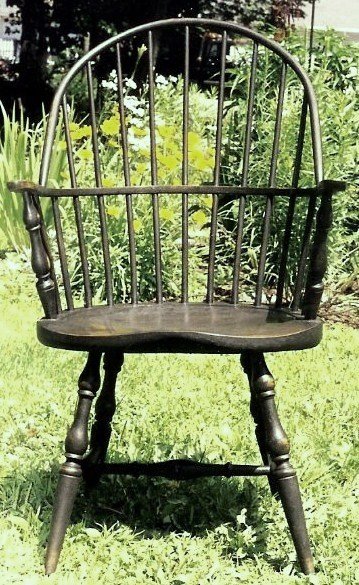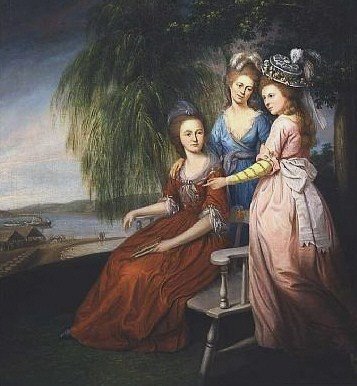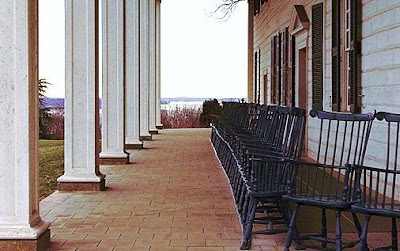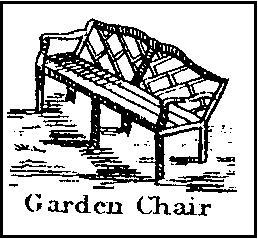Thomas Jefferson by Tadeusz Andrzej Bonawentura Kosciuszko (1746 - 1817)
On May 18, 1792, six men gathered in Philosophical Hall for the Friday meeting of the American Philosophical Society. Benjamin Smith Barton, professor of botany and natural history at the University of Pennsylvania, rose to read a letter he had written to a European botanist. In it he described an American wildflower, traced its short path through the scientific literature, and concluded that, as a genus "distinct" from any other, it was in need of a new name.
"I take the liberty," said Barton, "of making it known to the botanists by the name of J E F F E R S O N I A in honour of Thomas Jefferson, Esq. Secretary of State to the United-States." He added that his purpose was not to honor Jefferson's political character or his reputation for general science and literature. "My business was with his knowledge of natural history," he said. "In the various departments of this science, but especially in botany and in zoology, the information of this gentleman is equalled by that of few persons in the United-States."
The Society member honored in this act of scientific classification was absent--one would like to think because his mind was on zoology rather than botany. Earlier that day Jefferson had invited James Madison to his house to examine the difference between a "Northern hare" and a "common" one from the market, before they continued to Edmund Randolph's lodgings to dine.
But Jefferson's attendance at the meetings of the Philosophical Society had fallen off since the previous year, when he and Dr. Barton had collaborated energetically on investigations of the Hessian fly. The Society's minutes record the presence of their vice-president at only two of the Friday meetings in 1792, a year filled with the "hateful labours" of office and the intensifying disputes of partisan politics.
In this spring of 1792 Jefferson was abused as well as honored for his interest in natural history. In April he had been the target of the first round fired in the partisan pamphlet wars.
Massachusettensis (now thought to be British consul Sir John Temple), after attacking Jefferson as the intriguing "tool of a party," called for his "speedy retreat" to Monticello. There he could "range the fields of science, and the natural history of his country" without doing lasting harm to the nation. Jefferson's response was predictable: "However ardently my retirement to my own home and my own affairs, may be wished for by others as the author says, there is no one of them who feels the wish once where I do a thousand times."
His letters in this year are full of laments about being "shut up drudging within four walls" in Philadelphia and longing for the "tranquil" occupations of the fields and gardens at Monticello. And beyond Monticello was a whole unexplored continent to be studied--"What a feild have we at our doors to signalize ourselves in!" Having chosen the path of public leadership, Jefferson had to remain on the sidelines, cheering on American naturalists to their goal of revealing to the world the rich flora and fauna of the young nation.
Benjamin Smith Barton was perhaps Jefferson's greatest hope for leading the American team to eminence. The plant he had rescued from the wrong genus is what we know as twinleaf, a spring-blooming perennial of the woodlands of eastern North America. It entered scientific literature in 1753, when Linnaeus assigned it to the genus Podophyllum in his Species Plantarum. This work became our starting point for the naming of plants by introducing the binomial system which substituted two Latin names for the cumbersome Latin descriptions then current. Linnaeus likened his improvement to "putting the clapper in the bell" and sixty years later Jefferson was grateful. In 1814 he wrote that, "fortunately for science," Linnaeus had brought order out of chaos by providing a "universal language" for naming and classifying nature's productions.
Linnaeus had made his identification of twinleaf from a non-flowering specimen sent to him by a Virginian, John Clayton. Jefferson called the clerk of Gloucester County "our great botanist," and used the Flora Virginica, a compendium of Clayton's discoveries, when preparing the plant lists for his Notes on the State of Virginia. The first twinleaf to bloom before the eyes of botanists was collected in Virginia' Blue Ridge Mountains by Andre Michaux. Michaux's root first flowered in Bartram's Garden in Philadelphia in the spring of 1791 and was observed by Dr. Barton and William Bartram, who "together" made the first drawings of it.
Soon Jeffersonia became a feature of the gardens of Philadelphians, presumably those with republican leanings, but its namesake may never have seen it in the wild. Barton first saw it in its natural habitat at a site Jefferson had visited too late in the season. In 1802 Jefferson was living in "splendid misery" in the executive mansion and Barton was planning a botanising tour into the southern mountains. "I really envy your journey," wrote the President, "but I am a prisoner of state." He had to content himself with solitary rides out of Washington, during which, as Margaret Bayard Smith recalled, he would dismount "to climb rocks, or wade through swamps to obtain any plant he discovered or desired."
Passing through the Blue Ridge at Harper's Ferry in July, Barton saw "immense quantities" of twinleaf, past flowering, but could not find "even a single seed-vessel." He carried with him Jefferson's Notes on the State of Virginia, which contained a highly charged account of the meeting of the Potomac and Shenandoah rivers at this spot. Barton confided to his journal that what Jefferson called "one of the most stupendous scenes in nature" did not equal his expectations.
Barton arrived at the author's house in August, crossing the Rivanna River at the Shadwell ford and noting plentiful pawpaw trees, some castor-bean plants, and "a good deal" of horsemint. His fascinating journal then proves a major disappointment to future historians. "Monticello," written with a flourish and twice underlined, is followed by "Monticello is the beautiful seat of Mr. Jefferson," and not a word more--the rest of the page is blank. He elsewhere recorded his host's comments on the elevation of Monticello, its soil, and the scarcity of insects and insect-eating birds there (hummingbirds, however, were common). The President also shared his opinion that the counties along the eastern side of the Blue Ridge were the "healthiest" part of the United States. He had been told by an officer of the U.S. Army that this area produced "the largest men" among its recruits. Jefferson and Thomas Mann Randolph, Barton's former schoolmate at the University of Edinburgh, also contributed to the journal their comments on local plants, like honey locust, strawberry bush, and umbrella magnolia.
When Barton passed through Harper's Ferry again on his way north, he "sought in vain" for Jeffersonia, but found the scene far grander on a second inspection. The rocks were "indeed, stupendous," and had "an awful appearance." Perhaps Jefferson had responded to his initial disappointment with a story he had recently told another American botanist. When Samuel Latham Mitchill asked him for directions to the precise spot from which he had viewed the passage of the Potomac through the Blue Ridge, Jefferson replied that it was no longer there. During the Adams administration a military expedition was mounted to blow up the projecting rock, "doubtless," as the shocked Mitchill wrote his wife, "with the intention of falsifying his account, and rendering it incredible by putting it out of the power of any subsequent traveller to behold the like from the same point of view. What shameful, what vandalic revenge is this!" Nevertheless, when Mitchill later visited the site, he too joined the many disappointed tourists whose expectations had been raised by Jefferson's description.
Like Barton a physician-naturalist and former Edinburgh schoolmate of Thomas Mann Randolph, Mitchill was Jefferson's zealous lieutenant in Congress and frequent companion in the delighted contemplation of newly discovered inventions or natural productions. The man whom Jefferson called the "Congressional dictionary" kept a record of the curiosities he saw at the President's House. At dinner he marveled at exotic dates and ice cream in pastry, was tactful about water from the Mississippi and three-year-old pieces of the Mammoth cheese, and was relieved to find the meat well done, instead of the "half-raw Viands" served elsewhere. The "chatty and communicative" President showed him a wooden model of the moldboard of least resistance, minerals from Mexico and the American west, and mastodon bones from Big Bone Lick.
One day Jefferson proudly displayed a length of silk cloth produced by worms "bred in Virginia," after which he and Mitchill performed a little experiment together. Jefferson produced his surtout coat of British broadcloth waterpoofed by a new method. As Mitchill reported to his wife, the President "took hold of one part of the Skirt, and myself of the other end, so as by skilful holding to make a hollow or Cavity. Into this some water was poured. We stirred and moved it about. I put my hand to the under-side and agitated it there. But not a drop came thro. The President said he had hung up such a woolen-bag of Water for several weeks and it did not leak at all."
John Quincy Adams attended one presidential dinner, at which Jefferson and Mitchill enchanted the guests with their conversation, moving from the President's "usual" dissertation on wine to Epicurean philosophy to Fulton's steamboat to agriculture. Adams described Mitchill's conversation as "very various, of chemistry, of geography, and of natural philosophy; of oils, grasses, beasts, birds, petrifactions, incrustations...and a long train of et cetera." It was "one of the most agreeable dinners" he had had at the President's House.
Life on Pennsylvania Avenue must have resembled Benjamin Smith Barton's Chestnut Street establishment, where he worked "surrounded by books, bottles of insects, the bones of the mammoth, and other evidences of his ruling passion." A visitor to New York found Dr. Mitchill "surrounded by his cabinets of conchology and mineralogy, and with his room still further enriched with collections of Indian tomahawks and antiquities, and the dresses of the inhabitants of the south seas." Once he actually received his guests clothed in this Fiji Islands costume.
In 1803 Mitchill wrote that "botanists consider it an honor of the highest kind to be immortalized by having their names given to plants." The international code of botanical nomenclature made this distinction impossible for the good doctor. He cheerfully told his wife that Willdenow had wished to name a new plant after him but "was prevented by finding that the name had been bestowed already" (Linneaus had called patridgeberry Mitchella repens after John Mitchell of Virginia). Barton's honor came in the shape of an obscure plant of undistinguished appearance--Bartonia. And the rules of precedence prevented Jefferson from being immortalized twice.
John Brickell of Georgia tried in 1798 to apply the name Jeffersonia to the Carolina jessamine (now Gelsemium sempervirens), "in compliment" to the man "who, to his immense stores of other knowledge, has added the science of Botany."
In 1807 Barton complimented Jefferson again by forwarding a diploma of membership in the short-lived Linnaean Society of Philadelphia, which he had founded. In his letter of thanks Jefferson wrote that, although he was "sincerely associated with the friends of science in spirit and inclination," he regretted "the constant occupations of a different kind which put out of my power the proper cooperations with them, had I otherwise the talents for them."
A few months later he resisted Dr. Mitchill's efforts to induct him into another organization--the Tammany Society of New York. If the President accepted the invitation of this "vigorous part of the Republican Population," Mitchill was to "erect a Wigwam, to administer our obligation, to make known the tammanial pass-Word, Sign and Grip," and to deliver a copy of the war song, which "may afford a moment's entertainment."
The next year Jefferson finally reached the permanent harbor of Monticello, and ceased to worry about the hostilities of Federalists and Republicans. From his retirement Jefferson wrote Barton that "botany here is but an object of amusement, a great one indeed and in which all our family mingles more or less." He added regretfully, "My mind has been so long ingrossed by other objects, that those I loved most have escaped from it, and none more than botany, whose lodgement is made peculiarly in the memory."
By this time Jeffersonia had been introduced into English gardens by Scottish plant collector John Lyon and that Jeffersonian site--Harper's Ferry--was the home of the immigrants. On May 17, 1804, Lyon noted in his diary that he collected there "about 200 roots" of the twinleaf. Another plant enthusiast made a pilgrimage to the junction of the Potomac and the Shenandoah in 1817. A young Virginia lawyer, Francis Walker Gilmer, wrote to Jefferson of his journey to "Harper's Ferry, where all the regions of nature have conspired to do you honor." He gathered seeds of Jeffersonia to give to Jefferson's daughter Martha, because "its name will I am sure recommend it to her piety."
Jefferson never returned to the Blue Ridge gap where he had seen the "monuments of a war between rivers and mountains" in 1783. He remained close to his gardens at Monticello and Poplar Forest and, in 1823, considered ways to honor the man who had helped to clarify the "order of nature" by "uniting all nations under one language in natural history." Samuel Latham Mitchill had written suggesting that, as honorary members of the Linnean Society of Paris, he and Jefferson should simultaneously observe the birthday of Linnaeus on May 24th. Mitchill intended to celebrate this "fete botanique" in "a becoming manner" at Prince's garden in Flushing. "We shall think of you on the occasion," he wrote, "since we feel an assurance that you will not disapprove an attempt to render science popular and attractive."
Jefferson, in reply, regretted that he could not "join them physically on the occasion, but will certainly be with them in spirit. He will invite also some amateurs in natural science in his neighborhood to fraternize on the same day with their brethren of New York by corresponding libations to the great apostle of Nature." It is not known who shared the libations at Poplar Forest on the twenty-fourth--the last day of Jefferson's last visit.
And until almost the last day of his life he tried to pass his enthusiasm for natural history on to a younger generation. He worked to ensure the inclusion of botany, one of "the most valuable sciences," in the curriculum of the University of Virginia. It was time for the young to pursue his former passions. In 1822 Jefferson wrote to the discoverer of a new mineral, Jeffersonite. Thanking him for "the honor done my name by the appellation given it," he concluded that although "age and a decayed memory" had weakened his attention to the natural sciences, "nothing can ever weaken my affection to them, and the pleasure with which I observe so many of my young countrymen pursuing them with an ardor and success equally honorable to themselves and our country."
Lucia C. Stanton, Shannon Senior Research Historian, 1992
Research & images & much more are directly available from the Monticello.org website.








+The+Hervey+Converstion+Piece+The+Holland+House+Group.jpg)
+Francis+Vincent,+his+Wife+Mercy,+and+Daughter+Ann,+of+Weddington+Hall,+Warwickshire.jpg)

+The+Thomas+Cave+Family.jpg)

.jpg)
+Mr+and+Mrs+Van+Harthals+and+Son.jpg)
+Henry+Fiennes+Clinton,9th+Earl+of+Lincoln,+with+his+wife+Catherine+and+his+son+George+on+the+great+terrace+at+Oatlands+(2).jpg)

+An+Angling+Party+(perhaps+The+Willyams+Family+at+Carnanton).jpg)



%2C%2Bwith%2BHis%2BFamily%2C%2Bin%2Bthe%2BGarden%2Bof%2BGrove%2BHill%2C%2BCamberwell.jpg)


.+The+Grymes+Children-+Lucy+1743-1830,+Philip+1746-1805,+Jno+Randolph+1747-96,+Chas+1748-+.+Virginia+Historical+Society,+Richmond.jpg)
+Richard,+Mary,+and+Peter,+Children+of+Peter+and+Mary+du+Cane+Detail.jpg)
+The+James+Family.jpg)
.jpg)


+The+Mathew+Family+at+Felix+Hall,+Kelvedon,+Essex.jpg)

+A+Group+of+Gentlemen.jpg)

.+The+William+Denning+Family+vine+dog+urn+wall+chair.jpg)





+Detail.+Rice+Hope+Taken+from+One+of+the+Rice+Fields.+South+Carolina.+2.jpg)

.+The+Hartley+Family..jpg)
.+The+Enoch+Edwards+Family..jpg)

